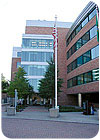
This facility houses hundreds of cancer research projects that must be maintained within stringent environmental conditions - any changes in temperature and humidity could influence the accuracy of long-running experiments, resulting in the loss of years of data, at costs running into millions of dollars. Fortunately, the facility’s staff had a plan in place when its cooling system failed.
As a world leader in biomedical research, Seattle’s Fred Hutchinson Cancer Research Center is dedicated to understanding, treating, and preventing cancer, HIV/AIDS, and other life-threatening diseases. The center was a pioneer in bone-marrow transplants as a treatment for leukemia and other blood diseases. With over 3,000 employees, the center has made some of the worlds most important medical research advances during the last three decades.
As one of 39 National Cancer Institute-designated comprehensive cancer research centers nationwide, and one of the largest in the world, the Hutchinson Center is home to many sensitive biological samples and experiments. Hundreds of simultaneous research projects must be maintained within stringent environmental conditions. Any changes in temperature and humidity could influence the accuracy of long-running experiments, resulting in the loss of years of data, at costs running into millions of dollars. In addition, potentially lifesaving advances in treatment could be delayed.
Failure on the worst day
Three cooling systems serve the center’s central freezer farm. On one of the hottest days of the year in Seattle - one system failed. The freezer farm has more than 100 freezers at -80°C, containing extremely valuable research. Maintaining -80°C is a complex operation and if the ambient temperature rises too high, the freezers become overstressed. With one cooling system down and the outside temperature reaching up to 80°F, there was cause for concern.As the facility staff went into action, the ambient temperature in the freezer farm began to creep upward, threatening millions of dollars of ongoing research. The A/C manufacturer reported that it would take about a week to get the needed parts. Something needed to be done immediately.
Robert Cowan, director of facilities engineering at the Hutchinson Center, had previously implemented a contingency plan for the freezer farm. As part of that plan, he called NC Power Systems, the Cat® rental dealer in Seattle. NC Power had worked at the campus before and knew its systems. The center had purchased and rented standby electrical generators from NC Power, which also maintains the center’s generators and had developed contingency planning for events like Y2K. NC Power had provided a 525-ton rotary screw backup cooling system earlier that same summer when the center’s 600-ton back-up chiller failed.
“Even though it was their standby chiller, the data and research at this institution is so valuable that they had to have redundant chilling capability,” said Dan Thomson, marketing manager for NC Power. This, however, was the first time Cowan and Thompson had worked together for air handling.
Putting the plan into action
On the day the cooling system failed, the Fred Hutchinson Cancer Research Center contacted NC Power rental salesman Charlie Tomsett. It was clear the center faced a critical situation. Tomsett immediately made calls to arrange for delivery of a 30-ton, 10,000 cfm chiller from the NC Power inventory. As part of the contingency plan, the rental team knew that the equipment would have to be set up on the engineering department’s loading dock.Tomsett also arranged for a 100 kW XQ100 sound-attenuated generator to power the temporary chiller. The NC Power team quickly packaged, delivered, and set up the equipment. Then they connected it to the building HVAC system with portable 20-in. ducting.
Just four hours after the cooling unit failed, NC Power had the emergency cooling system online. As soon as the turnkey system was started, the temperature inside the building began to fall, cooling the building and protecting its valuable inventory of scientific knowledge.
The rental system ran without trouble for a week while the building’s A/C unit was repaired. While technical help from NC Power was readily available, the center did not need any work or maintenance on the temporary system during its operation. Thomson, for one, was pleased that everything worked out well. “You’re never going to duplicate that research,” he stated.ES
